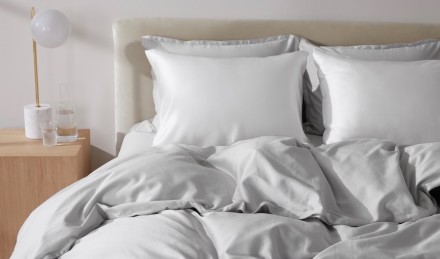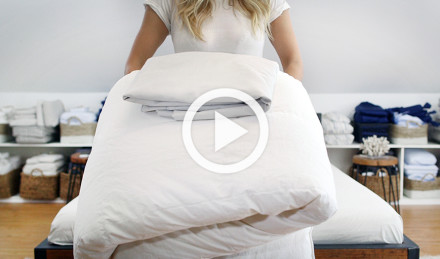If you’re investing in the luxury of a silk pillowcase, you want your bedding to last for years. You also want it to continue feeling soft, smooth and sumptuous every time you lay your head on it. After all, the beauty benefits of sleeping on silk — like healthier-looking skin and less tangled hair — depend on the fabric retaining its exceptionally soft, sleek features.
By understanding the best way to wash silk pillowcases, as well as dry and store them, you’ll be able to enjoy more nights of restful, rejuvenating slumber. Here’s what you need to know.
How to Wash Silk Pillowcases
How to Wash Silk Pillowcases
Knowing how to wash silk pillowcases properly will help extend the life of the bedding while allowing it to maintain the silky smooth qualities that make silk such a luxurious fabric.
To start, it’s important to know what type of silk you’re washing. Mulberry silk, made with refined, durable and uniform fibers, is considered the highest-quality silk available for purchase. Learning how to wash mulberry silk pillowcases will help this finest silk retain its exceptionally soft, smooth characteristics.
Although the material is delicate, the silk fiber is strong enough to stand up to occasional machine washing. However, hand washing your silk pillowcases is recommended to help the fabric retain its soft, silky traits. We’ll explain both methods so you’ll have a convenient machine-washing option when you’re short on time.
Whichever washing method you choose, remember that a gentle but effective liquid toxin-free laundry detergent is the best detergent for silk pillowcases (and for your health!) Avoid harsh liquid and powdered detergents, as these products coat and weaken the natural fibers.
Here are the steps to follow, whether you’re hand washing or machine washing your silk pillowcases.
How to Hand Wash Silk Pillowcases
Whenever possible, hand wash your silk pillowcases to avoid deterioration of the fibers. Follow these steps when hand washing silk pillowcases:
Fill a clean sink or bowl with cold or cool water. Cool water will help the fabric retain its color.
Add a few drops of mild liquid Laundry Detergent.
Turn your silk pillowcase inside out to further protect the fabric, then place it in the water. Use your hand to gently agitate the water.
Remove the pillowcase and gently squeeze out the water and detergent. Do not twist or wring the pillowcase, as silk’s fibers are weaker when they’re wet.
Drain and refill the sink or bowl with cold water and repeat steps 3 and 4 at least four times to ensure the pillowcase is clean and free of any detergent.
How to Machine Wash Silk Pillowcases
Follow these steps when machine washing silk pillowcases:
Turn the pillowcase inside out and place it in a mesh washing bag.
Select the delicate cycle on your machine.
Wash the pillowcase in cold water with a small amount of gentle liquid laundry detergent.
How to Dry Silk Pillowcases
Knowing how to wash silk pillowcases properly will help ensure the fabric’s longevity and continued softness.
The first thing you need to know about how to dry silk pillowcases is that you should never put them in the dryer. The high heat of a dryer — even on a low setting — will destroy the silk’s fiber.
Instead, follow these steps to dry a silk pillowcase:
If there is excess water still in the fabric, place the pillowcase on a clean, dry towel and blot out the excess moisture. Do not wring out the pillowcase, as this will damage the fiber.
Lay a silk pillowcase flat to air dry, preferably on a drying rack away from direct heat sources and sunlight. Laying it flat to dry will help the pillowcase retain its natural shape, and keeping it out of direct heat or sunlight helps prevent discoloration and fading.
If the pillowcase’s fabric wrinkles after it’s finished drying, gently steam the piece to remove wrinkles and bring back the luster of the material. You can also iron a silk pillowcase by turning the pillowcase inside out. Use the lowest temperature setting and place a pressing cloth or a clean piece of fabric between the iron and the silk.
How to Dry Silk Pillowcases
Knowing how to wash silk pillowcases properly will help ensure the fabric’s longevity and continued softness.
The first thing you need to know about how to dry silk pillowcases is that you should never put them in the dryer. The high heat of a dryer — even on a low setting — will destroy the silk’s fiber.
Instead, follow these steps to dry a silk pillowcase:
If there is excess water still in the fabric, place the pillowcase on a clean, dry towel and blot out the excess moisture. Do not wring out the pillowcase, as this will damage the fiber.
Lay a silk pillowcase flat to air dry, preferably on a drying rack away from direct heat sources and sunlight. Laying it flat to dry will help the pillowcase retain its natural shape, and keeping it out of direct heat or sunlight helps prevent discoloration and fading.
If the pillowcase’s fabric wrinkles after it’s finished drying, gently steam the piece to remove wrinkles and bring back the luster of the material. You can also iron a silk pillowcase by turning the pillowcase inside out. Use the lowest temperature setting and place a pressing cloth or a clean piece of fabric between the iron and the silk.
How to Properly Care for Silk Pillowcases
Properly cleaning silk pillowcases will help increase the fabric’s longevity and characteristic silky smooth texture. However, there’s more to caring for silk pillowcases than washing and drying. Here are even more ways for how to care for silk pillowcases, including how to store them, how often to wash them, how to keep them soft and how to remove stains.
How to Keep Silk Pillowcases Soft
How to Properly Care for Silk Pillowcases
Properly cleaning silk pillowcases will help increase the fabric’s longevity and characteristic silky smooth texture. However, there’s more to caring for silk pillowcases than washing and drying. Here are even more ways for how to care for silk pillowcases, including how to store them, how often to wash them, how to keep them soft and how to remove stains.
How to Keep Silk Pillowcases Soft
Follow these additional tips to help ensure your silk pillowcase will continue to feel soft and sumptuous every time you lay down on it:
Use less detergent than the manufacturer’s recommendation. Detergent can build up on your pillowcase and coat the fabric’s fiber, making it feel stiff and smell like mildew.
If you do notice a buildup of detergent on the fabric, soak your silk pillowcase in a basin of cold water and one tablespoon of white vinegar, which will help cleanse the fibers. Then hand wash and dry the pillowcase as usual.
Remember that silk gets its smooth, soft surface from the fiber’s long filaments. Decrease the chances of weakening those fibers by avoiding wringing or stretching the cloth, especially when the fabric is wet and the fibers are most vulnerable.
If you’re ironing a silk pillowcase, avoid creating sharp edges or creases in the fabric, which can cause the fiber’s long filaments to bend or break.
How to Store Silk Pillowcases
A high-quality pillowcase is the most effective at protecting your skin and hair if it’s free of creases and wrinkles in the fabric. So when you’re storing silk pillowcases, use a wide-bar hanger, and avoid using clips to hang them, as the clips will imprint on the fabric.
For long-term storage of silk pillowcases, first ensure the pillowcase is freshly cleaned and completely dry to avoid attracting moths.
To further protect silk pillowcases from bugs and ensure the fabric’s longevity, store pieces in a breathable garment bag.
How Often to Wash Silk Pillowcases
Silk pillowcases, like your other bed linens, come into direct contact with your skin every night, so it’s important to wash them regularly — typically about every seven to ten days. To learn more about washing bed linens, check out this guide to washing and properly caring for bedding.
Washing your bed linens regularly removes the dead skin cells, oils and dirt that accumulate on the fabric and can end up damaging the fibers.
Silk pillowcases should be cleaned as regularly or even more often than linens, because they can be an integral part of your face and hair beauty routine. Silk’s protein fiber has a lower absorption rate than linen or cotton pillowcases, so a silk pillowcase naturally absorbs less of your beauty products while you sleep. Those beauty products can accumulate on the fabric and damage it, so you may want to wash silk pillowcases as often as once or twice a week.
To reduce the wear and tear of frequent washing and drying, keep at least one extra set on hand, so you can rotate them for use on your bed.
For the littlest luxury lovers, you may be wondering how often to wash baby-size silk pillowcases.
As with your other baby bedding, a baby silk pillowcase should be laundered at least once or twice a week — or whenever one becomes soiled. If your little one won’t sleep on anything but silk, make sure you have at least two or three sets on hand, in case of late-night accidents.
How to Remove Stains From Silk Pillowcases
Accidents happen. The key to keeping that coffee, wine or other stain from setting in your silk pillowcase is to treat the fabric promptly and carefully.
Here’s a step-by-step guide for how to remove stains from silk pillowcases:
Apply a few drops of mild laundry detergent directly to the stain. Using your finger, gently massage the detergent into the fabric. Do not use bleach on a silk pillowcase, as the harsh chemicals will destroy the fibers.
Leave the detergent to sit on the stain for at least 15 minutes.
Hand wash and dry your pillowcase as usual. If there’s a concern about detergent buildup, add a tablespoon of white vinegar to a basin of cool water and let the fabric sit for five minutes, then proceed with hand washing and drying your pillowcase as usual.
For extra tough stains, bring your pillowcase to a dry cleaner. Be sure to point out the stains and explain what at-home remedies you’ve tried so the cleaners can determine next steps.
And remember that the longer you wait, the less likely it is that you’ll be able to remove a stain from a silk pillowcase.
If you notice your silk pillowcases are becoming stained or discolored over time, it’s likely a buildup of detergent or bodily fluids on the fabric. You can clean a silk pillowcase, remove yellowish discoloration and restore the original color by soaking it for approximately five minutes in a basin of cool water and one tablespoon of white vinegar. When it’s finished soaking, hand wash the pillowcase and dry as usual.
Where to Buy Silk Pillowcases
When properly cared for, high-quality silk pillowcases and other types of bedding should last for years. The Silk Pillowcase you’ll find at Parachute is made with 25 momme mulberry silk — the highest quality silk on the market.
Be sure to also explore the Parachute laundry products for fresh smelling, eco-friendly washing and drying.
Read on for more wash and care guides and other home essential tips and information:
Ultimate Chores List: Daily, Weekly, Monthly Chores for You & Your Family
Laundry Room Accessories 101: Laundry Essentials for Clean Living
How to Wash, Dry, and Properly Care for Percale Cotton Sheets
Do Wool Dryer Balls Really Work? Everything You Need to Know
Pillowcase & Sham Guide: How to Choose the Best Options for Your Bedroom
Where to Buy Silk Pillowcases
When properly cared for, high-quality silk pillowcases and other types of bedding should last for years. The Silk Pillowcase you’ll find at Parachute is made with 25 momme mulberry silk — the highest quality silk on the market.
Be sure to also explore the Parachute laundry products for fresh smelling, eco-friendly washing and drying.
Read on for more wash and care guides and other home essential tips and information:
Ultimate Chores List: Daily, Weekly, Monthly Chores for You & Your Family
Laundry Room Accessories 101: Laundry Essentials for Clean Living
How to Wash, Dry, and Properly Care for Percale Cotton Sheets
Do Wool Dryer Balls Really Work? Everything You Need to Know
Pillowcase & Sham Guide: How to Choose the Best Options for Your Bedroom









